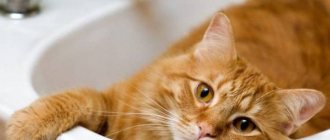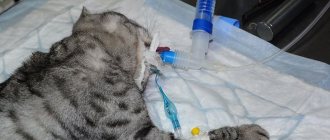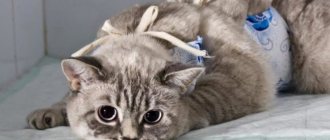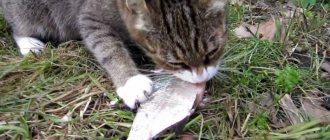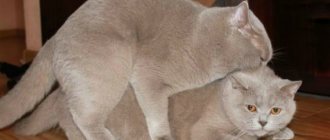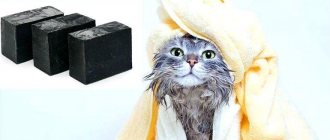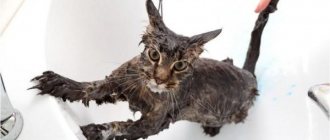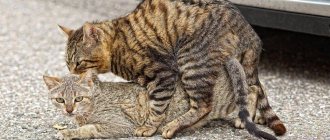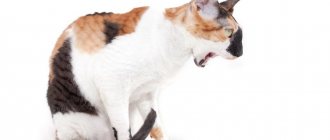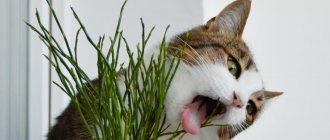An important step to maintain the beautiful appearance and health of the animal is drying the cat after the bathing procedure. It is a misconception that you cannot blow dry a cat. Wet wool in cold and drafts contributes to hypothermia, which ultimately leads to infectious diseases that make pets vulnerable. If from a young age the pet is accustomed to the noise from the operation of the device and a large air flow, then this procedure will save you from colds and the coat will become shiny and soft.
Is it possible to blow dry a cat after bathing?
A hairdryer is the main tool used to dry cats. But you should do it wisely. First of all, don't stick the hair dryer directly into your face - keep it at a distance. Secondly, turn on the average temperature - there is no need to dry the cat with Sahara air. Many tailed animals are afraid of the hair dryer, or rather the noise it makes. In this case, you need to either purchase a quieter unit, or use a heater-wind blower: it can be placed directly in front of the cat, directing the air flow in the desired direction. A wind blower produces quieter sounds and covers a larger area than a hair dryer. It often ends with the cat realizing that this is a source of heat, and therefore moving closer.
Step-by-step instruction
Step #1. Drying the cat
Immediately after bathing, the cat needs to be carefully wiped down, without, of course, giving her a concussion. It’s better not to even wipe, but to get wet. And let her shake herself off, which is also quite effective.
After the cat has shaken itself off and you have thoroughly blotted it, take another towel and wrap it in it. The size should be chosen so that the cat fits entirely into the fabric. It is desirable that the towels are terry, soft, and environmentally friendly.
Step #2. Let's go into the warmth
Before bathing, you should think about where you will dry the cat. We take the cat there while he is still in the towel. We put it in a towel on our hands or, for example, on a table or on a sofa.
Step #3. Drying
Turn on the hairdryer and place it nearby: let the cat get used to the noise. At first, the cat will be afraid of the hair dryer, but there is no need to follow the animal’s lead and immediately turn off the noisy device as soon as the cat starts screaming or shaking. Let him understand that such behavior does not lead to the desired result. And after a few minutes, when the animal realizes that the hairdryer is the source of heat that he now so needs, he himself will not want it to be turned off.
There is no need to direct the air flow directly to the face: the cat will consider this a threat. It is better to direct the air from the side, above or behind.
While drying, the cat needs to be combed. But not immediately, but as soon as the wool dries at least a little. If the fur is long and very tangled, you can purchase special conditioners at the pet store that help prevent it from tangling.
You need to scratch the cat both in the direction of hair growth and against the hair in order to dry the inner layer. Otherwise, the cat will be dry on the outside, and a wet layer will form under the fur - and the animal may get sick. If your cat does not tolerate brushing against the grain at all, brush according to the growth of the fur, and direct only the hair dryer air against the grain.
You can comb your cat with a regular fine-toothed comb, or you can use a special paw, which is the most effective tool designed specifically for cats. But it is not suitable for all cats. Some people hate her, some love her. Not every type of fur is easy to comb out with it. It is more convenient for the author of the article to work with his paw on short-haired animals and uncomfortable on long-haired animals. For some, it's the opposite. It's a matter of skill, but the paw is cheap, so you can try.
Step #4. We encourage
After the procedure, give the cat a treat. Then the cat will develop a reflex that bathing and drying ends pleasantly for him, and next time he will not react so sharply to the event.
Source
Is it possible to bathe a pregnant pet?
Before performing the bathing procedure, it is worth learning about other methods of care that are most suitable for a cat in this situation. You can visit a veterinarian with your cat, he will examine the animal and be able to clean the fur from fleas and parasites, if any. Thus, the risk of harm to the fetus is minimized. You can get advice from your veterinarian about safe grooming methods. If the cat is already accustomed to water procedures and the aromas of detergents, then bathing is allowed. If there are negative associations and emotions with water, it is necessary to wash the fur as carefully as possible, without sudden movements, and do not forcefully hold it by the withers, causing pain.
When bathing, it is recommended to follow specific tips that will facilitate this process:
- The temperature should be comfortable for the pet. You should carefully ensure that the water is warm, and in no case hot or cold, as temperature changes can cause miscarriage or a cold.
- If there is no severe contamination throughout the body, for example, if only the paws are dirty, it is not recommended to bathe the cat completely; it is enough to wash only the pads and fur on the paws.
- It is not recommended to wash your cat with shampoo unless absolutely necessary. If you have fleas and parasites, the right solution would be to purchase skin capsules or a specialized collar. You can use dry shampoo, which does not require water to work.
Why is it not advisable to swim?
If bathing is very stressful for your pet, then it is better to postpone the procedure and do it only in case of severe contamination.
Cats require special care for their coat during pregnancy. When an animal licks itself, it can swallow the remains of detergents with saliva. Taking water procedures is a strong stress for the pet, which will not bring benefits for her and future offspring. But there are situations when bathing cannot be avoided: accumulated dirt and dust on the coat after walks, or if parasites have appeared.
You can bathe your pet only when using other hygiene products is pointless, and you should take into account the health status of the pet and its general well-being. It is not recommended to take water procedures for those whose pregnancy proceeds with complications, and in the first weeks, as this is a strong stress
How to prepare to wash your cat
Before swimming, prepare all the items that may be useful to you during the process. As a soap, you need to use special shampoos for cats. Regular human shampoos will not work because their composition can damage the cat's soft fur and make it coarse. In addition, human shampoo has a powerful fragrance that remains on the hair or coat for a long time. If a cat smells something foreign for a long time, its sense of smell will be affected, and the animal may lose its sense of smell. Therefore, it is better to buy a special shampoo at a veterinary pharmacy, but not for dogs, but specifically for cats. Some manufacturers add special components to the shampoo that protect the animal's fur from insects.
Can I bathe my cat with regular shampoo?
Cats, like other animals, need to be bathed only with special shampoos.
What to bathe with
your pet? Is it possible to use “human” shampoos? And is shampoo alone enough?
All these are important questions, the answers to which every owner who loves and cares for their cat should know.
Nowadays there is a very wide range of products for bathing cats. Therefore, you can easily choose exactly what is right for you and in your specific situation.
Shampoo alone
- this is what experts say.
Still, it is better to use a special conditioner after shampoo. You also need to know that, almost always, shampoos are concentrated and are used only after dilution with water. Dry shampoos and conditioners
do not give the desired result, and they can only be used in extreme cases.
Video: how to wash a cat if he doesn’t like water
There are many funny stories, photographs and other positive emotions associated with pets. But, unfortunately, there are no less questions about their upbringing, maintenance, and most importantly, care.
One of the most exciting questions among owners of furry animals is “How to dry a cat after bathing?” In searching for an answer to this question, you may encounter different opinions, both among veterinarians and among cat owners.
Therefore, in order to find out the answer to the question asked, you should generally consider the psyche and health of cats in order to understand whether a person will harm it by using a hair dryer to dry their fur.
The structure of the psyche and the health of cats
The irrefutable fact is that the vast majority of cats do not like water.
, and with it the process of bathing. This is due to the fact that they are by nature more inclined to observe what is happening than to make direct contact. In addition, cats are generally self-contained and being forced to interact with humans repels them.
To top it all off, cats don’t understand the need to wash themselves, as they can clean themselves perfectly well. In this matter, much depends both on the mood of the animal and its owner, and on the cat’s health. You need to learn to choose the moment when bathing will not cause so many negative emotions and will not harm your pet’s psyche in any way.
Do not forget that after bathing, your pet should not be left wet. Cats differ in their health status, but no matter how strong it is, it’s not worth the risk. A wet animal can easily catch a cold by running or even just lying in a draft
This can also lead to hypothermia and, what is important for owners, wet wool has a stronger odor, is prone to tangling, the formation of pellets and, of course, debris sticks to it
In this regard, it becomes obvious that the cat is not afraid of bathing, but of the trouble it causes her. If you have already decided to give your pet a bath, be sure to warm it up and dry it afterwards, preferably with a hairdryer.
And here the next point appears, related to the fact that cats are afraid of loud sounds and noise. Most often, this is due only to the suddenness of the appearance of such stimuli or the animal’s perception of them as precursors of something bad. All these experiences cause fear in the cat and a desire to hide.
It is important to note that each cat has a different character and therefore they do not calm down equally quickly after a stressful situation. In general, the main task of the owner is the need to protect the pet from severe shock
How to make friends with a cat and a hairdryer?
The most effective will be the presence of a hairdryer in the life of a new pet from infancy. This does not mean that you need to bathe him every day. It will be enough to periodically turn on the hair dryer at minimum power in the presence of the animal, sometimes closer, sometimes further from it. If the cat’s reaction is positive, it is imperative that you praise it, stroke it, give it a treat and demonstrate sincere joy with your entire appearance. This is very important, since animals are very sensitive and easily determine the mood of the owner. A pleasant atmosphere will eradicate your cat's fear of a hair dryer.
If the situation is complicated by severe trembling, meowing and other negative indicators of the cat’s condition, you should not immediately turn off the hair dryer. Thus, the animal may develop a misunderstanding of what is happening and the reflex of demonstrating hysteria to stop unwanted actions will be reinforced. In such a situation, you need to remember who is the owner and persistently, but with understanding and love for the animal, continue to take steps to accustom the cat to the hair dryer.
In adult cats and cats, the period of getting used to the hair dryer should be carried out in exactly the same way, only you need to be prepared for the fact that it will take longer.
Adult cat's first bath
The cat needs to get comfortable in the bathroom
There may be situations when you have to accustom an adult animal
. For example, if you adopted an adult cat who previously lived on the street.
As always, the main thing is your love, patience and self-control
. In principle, the process of accustoming and bathing itself is not much different from the usual one. It just might take a little longer. And you can get acquainted with the procedure and the environment in a dry bath. And even if your pet runs away, you shouldn’t despair. Everything will work out, it just takes a little more time and patience.
One of the important factors for creating favorable conditions for bathing your pet is lighting in the bathroom.
. Insufficient lighting can be another cause of stress in an animal.
How to properly blow dry a cat?
To prevent your cat from experiencing any discomfort while blow-drying, you need to do it correctly:
- After bathing your cat, you need to turn on the hair dryer and leave it next to her. This trick will help her get used to the noise.
- While the cat gets used to the sound of the hair dryer, dry its fur with a towel.
- Organize an atmosphere for your cat in which she will be as comfortable as possible. The ideal option would be to take your pet in your arms or lay it on your lap, or sit the animal on a mat.
- To make the hair comb better, you can use special products that are sold in pet stores, veterinary pharmacies and veterinary clinics.
- You can begin the drying process. The main thing to remember is that it is unacceptable to direct a direct flow of air from the hair dryer into the cat’s nose. This action is perceived by the cat as a threat, so it will try to escape.
Pros and cons of this drying method
There is an opinion that drying an animal with a hairdryer will lead to a deterioration in the condition of the coat and even the development of dermatitis. However, this is not true. If you select the correct mode of operation of the device, drying does not harm your pet.
At the same time, for some cats, being near the device can be extremely stressful. There is evidence that some individuals refuse food and behave restlessly for several days after the procedure.
Similar reactions are more often observed in old and particularly timid animals. After several procedures, the pet will get used to them.
Using a hair dryer for drying is not only possible, but also necessary. If the fur remains wet for a long time, the cat is highly likely to become hypothermic. This can lead to decreased immunity, colds and dermatitis. Thus, to quickly dry your pet's fur, you need a hairdryer.
The device must be used correctly. It should be set to low or medium operation so that the air does not get too hot. It is not recommended to bring the device too close to the animal’s body, because exposure to heat may cause discomfort in your pet.
Rules for drying a cat with a hairdryer
The entire drying period can be divided into several stages:
- First you need to lightly dry the animal from above with a powerful stream of air.
- At a lower power of the hairdryer, using a comb, you should thoroughly dry the entire body of the animal against the hair, slightly pulling out the fur.
- The cat should be dried starting from the hind legs, when the animal lies on its back. All movements should be smooth and slow enough so as not to frighten the pet. You can hire someone to help you pet the animal.
If you are not lazy and spend a little time preparing your cat for bathing and then drying the fur with a hairdryer, then the whole procedure will be painless for both the animal and its owner.
Cats do not like water and try in every possible way to avoid contact with it. These furry hydrophobes are even more afraid of buzzing and noisy household appliances. Therefore, trying to dry the cat with a hairdryer
often turns into torture, both for the animal and for its owner. What to do and how to accustom furry panties to this procedure?
Rules of procedure
What not to do?
- Leave the animal alone with the hairdryer running.
- Allow wet cats to come near electrical outlets.
- Without drying the pet, release it half wet.
- Screaming while drying.
- When drying yourself, keep the animal in a wet towel for a long time.
- Leave it to dry on its own, especially during the cold season.
- After the procedure, leave outside or in drafts for 24 hours.
How to properly dry a cat with a hairdryer?
The device must have a multi-stage power regulator.
For effective drying, you will need a hair dryer, a brush for combing the wool and the patience of the owner. It is recommended to adhere to the following rules:
- Turn on the device at medium or minimum power with a small air flow.
- You need to dry the kitten from the head area, then the neck.
- Then the forelimbs are dried.
- Gradually you should move to the cat’s stomach, and then to the back.
- Finally, dry the pet’s hind legs and tail, and carefully pass a stream of air over the pads.
When drying and after the procedure, it is necessary to talk to the animal, stroke and praise. This way, the cat will feel more confident and less stressed.
A few rules for proper blow drying
1. The device must be turned on in advance. Let the cat get used to its noise.
2. First, the wool is slightly dried using hygroscopic towels.
3. The animal’s paws should not slip. It is best to sit him on your lap or spread a rug.
4. To make combing easier, you need to use special products for animal hair. This could be an antistatic spray or a liquid to prevent tangles from forming.
5. There is no need to direct a direct stream of air into the cat’s nose. He will perceive this as a direct threat to his life and will try with all his might to get out.
Special devices
Nowadays there are many hair dryers on sale that are designed for drying animal hair. Such devices are equipped with a temperature regulator and come with a set of attachments that make the procedure easier. In addition, such devices make almost no noise. The following models are especially popular among cat breeders:
- Metrovac Air Force Commander.
- Tenberg Sirius Pro.
- XPOWER B-4.
- KOMONDOR F-01.
- DIMI LT-1090.
- Codos CP-200.
- LAN TUN LT-1090, etc.
Why do you need blow drying?
1. It is dangerous to leave an animal’s fur under-dried, especially if the house is cold and there are drafts - you can seriously catch a cat’s cold.
2. Wet wool is prone to tangling and all sorts of debris sticks to it. So, if you are too lazy to dry the cat, you risk getting a result even worse than before washing and all your work will go down the drain.
3. Trying to dry itself, the cat will lick the fur, and a certain amount of bathing agent will remain on it. This can lead to serious poisoning of the animal.
How to dry?
Drying occurs in 2 stages:
1. The animal’s fur is slightly dried on top with a strong stream of warm air.
2. Reduce the power of the hair dryer and dry the cat using a wide-toothed comb.
When drying, you must follow all safety precautions when working with electrical appliances:
Do not handle the hair dryer with wet hands; make sure that the wire is not damaged; feet should be dry; The cat should be seated on a rubber mat.
If all of the above conditions have been met, then drying a cat with a hairdryer will not cause unpleasant memories for either the animal or its owner.
Immediately after bathing, the cat needs to be carefully wiped down, without, of course, giving her a concussion. It’s better not to even wipe, but to get wet. And let her shake herself off, which is also quite effective.
After the cat has shaken itself off and you have thoroughly blotted it, take another towel and wrap it in it. The size should be chosen so that the cat fits entirely into the fabric.
It is desirable that the towels are terry, soft, and environmentally friendly.
Step #2. Let's go into the warmth
Before bathing, you should think about where you will dry the cat. We take the cat there while he is still in the towel. We put it in a towel on our hands or, for example, on a table or on a sofa.
Step #3. Drying
Turn on the hairdryer and place it nearby: let the cat get used to the noise. At first, the cat will be afraid of the hair dryer, but there is no need to follow the animal’s lead and immediately turn off the noisy device as soon as the cat starts screaming or shaking. Let him understand that such behavior does not lead to the desired result. And after a few minutes, when the animal realizes that the hairdryer is the source of heat that he now so needs, he himself will not want it to be turned off.
There is no need to direct the air flow directly to the face: the cat will consider this a threat. It is better to direct the air from the side, above or behind.
While drying, the cat needs to be combed. But not immediately, but as soon as the wool dries at least a little. If the fur is long and very tangled, you can purchase special conditioners at the pet store that help prevent it from tangling.
You need to scratch the cat both in the direction of hair growth and against the hair in order to dry the inner layer. Otherwise, the cat will be dry on the outside, and a wet layer will form under the fur - and the animal may get sick.
You can comb your cat with a regular comb with fine plastic teeth, or you can use a special paw, which is the most effective tool designed specifically for cats.
